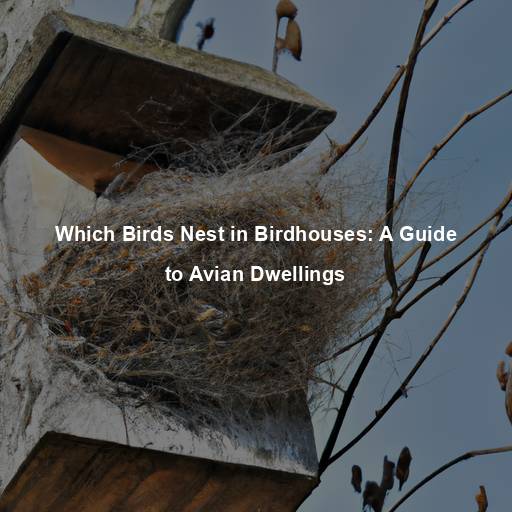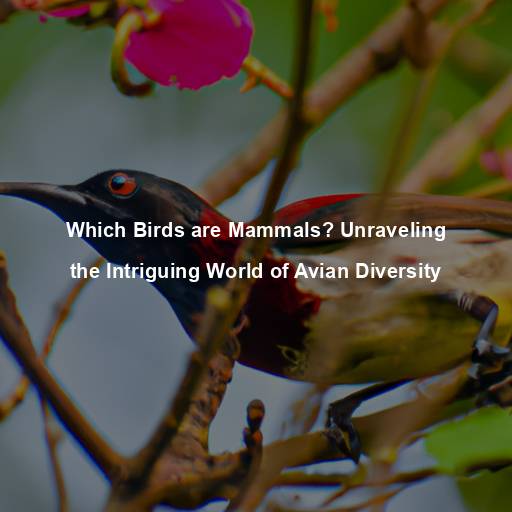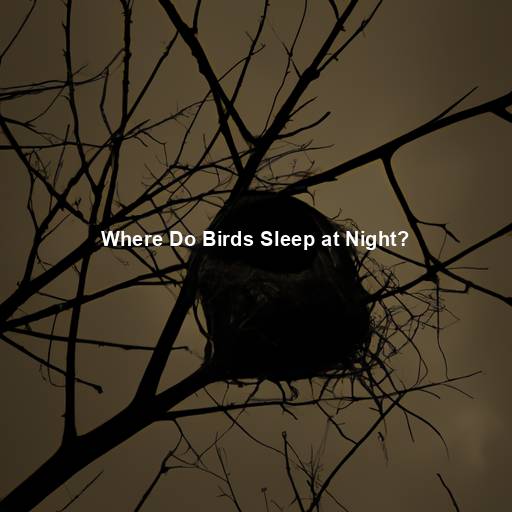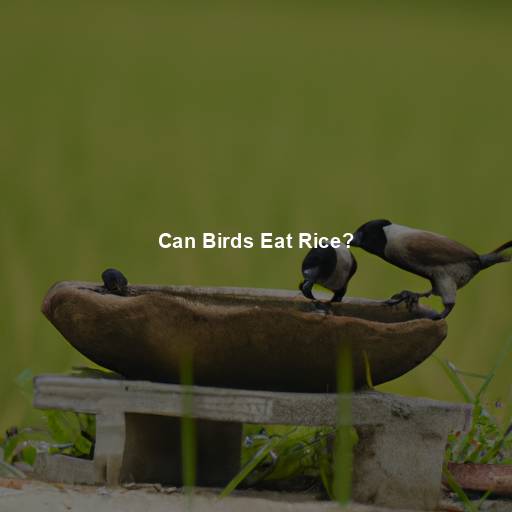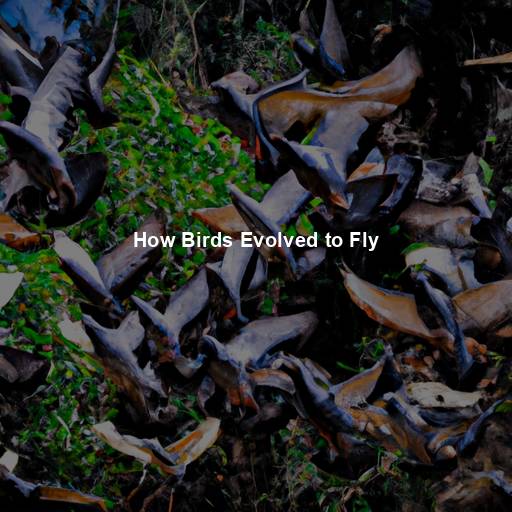Which Birds Nest in Birdhouses: A Guide to Avian Dwellings
Last Updated on August 3, 2023 by Evan
Birds are fascinating creatures that captivate our attention with their vibrant plumage, melodic songs, and graceful flight. One of the most delightful sights is witnessing birds building their nests and raising their young. While many birds choose to build their nests in trees or shrubs, some species have adapted to using man-made structures such as birdhouses or nest boxes. In this comprehensive guide, we will explore the types of birds that nest in birdhouses, the key considerations for setting up a birdhouse, and the importance of providing suitable habitats for our feathered friends.
Contents
- 1 Understanding Avian Dwellings: The Fascinating World of Birdhouses
- 1.1 Types of Birds That Nest in Birdhouses
- 1.2 Choosing the Right Birdhouse: Key Considerations
- 1.3 Location, Location, Location: Placing Your Birdhouse for Success
- 1.4 The Importance of Nesting Opportunities: Conservation and Enjoyment
- 1.5 Maintaining and Monitoring Birdhouses: A Responsibility
- 1.6 The Joy of Welcoming Avian Neighbors: A Rewarding Experience
- 1.7 Native Plants: A Natural Haven
- 1.8 Water Features: A Refreshing Oasis
- 1.9 Food Sources: A Nourishing Buffet
- 1.10 Natural Nesting Materials: An Abundant Supply
- 1.11 Predator Deterrents: Ensuring Safety
- 2 The Art of Observation: Enjoying the Nesting Journey
- 3 A Shared Responsibility: Conservation and Stewardship
- 4 A Symphony of Life: Celebrating the Avian World
- 5 FAQs: Which Birds Nest in Birdhouses
- 5.1 What type of birds use birdhouses for nesting?
- 5.2 What features should a birdhouse have to attract nesting birds?
- 5.3 What size entrance hole do different bird species require?
- 5.4 What is the best location for a birdhouse?
- 5.5 How can I make my birdhouse more attractive to nesting birds?
- 5.6 How do I maintain a birdhouse for nesting birds?
Understanding Avian Dwellings: The Fascinating World of Birdhouses
Creating a welcoming abode for our avian friends, birdhouses, or rather the fancifully coined “nest boxes,” offer a haven of solace and sanctuary where birds can nurture their offspring. These ingeniously designed habitats cleverly mimic the nooks and crannies found within the generous embrace of trees, offering a captivating alternative for our cavity-nesting companions. By thoughtfully situating these charming abodes in the idyllic confines of our backyards, gardens, or any fitting locale, we become instrumental in preserving these delicate creatures’ existence, safeguarding their pivotal contributions to the intricate tapestry of our ecosystems.
Types of Birds That Nest in Birdhouses
A variety of bird species are known to utilize birdhouses for nesting purposes. Some of the most common species include:
- Eastern Bluebirds (Sialia sialis): These striking birds with their vibrant blue plumage are a favorite among bird enthusiasts. Eastern Bluebirds are cavity nesters and readily accept birdhouses with the correct specifications.
Chickadees, oh the delightful creatures! With their joyful melodies and playful acrobatics, these small birds never fail to bring a smile to our faces. And let’s not forget their affinity for cozy birdhouses, always ready to make a new home for themselves. It’s simply fascinating how they embrace these man-made structures with such enthusiasm, as if they were tailor-made for their petite frames. - Tree Swallows (Tachycineta bicolor): These graceful aerialists are known for their dazzling aerial displays. Tree swallows are cavity nesters and readily use birdhouses, especially in areas near open fields and water.
- Wrens (Troglodytidae family): Wrens are small, energetic birds known for their loud songs. Various species of wrens, such as the House Wren and Carolina Wren, readily nest in birdhouses.
- Purple Martins (Progne subis): These charismatic birds are the largest species of swallow in North America. Purple Martins are highly social and often form colonies of nesting pairs in specialized birdhouses known as martin houses.
Ever wonder about those fascinating creatures that have the incredible skill to maneuver themselves downwards on trees? Well, look no further than the elusive nuthatches. These little acrobats of the avian world are famous for their headfirst descents along the trunks of trees. And if that wasn’t intriguing enough, some species, like the White-breasted Nuthatch, have even been known to cozy up in birdhouses for their nesting needs.
When it comes to feathered residents, one size certainly does not fit all. Each bird species comes with its own set of nesting preferences, making it crucial to provide customized accommodations. By offering specially-designed birdhouses that cater to their specific needs and wants, you can enhance the chances of enticing these beautiful avian creatures to make your place their cozy home.
Choosing the Right Birdhouse: Key Considerations
Choosing the proper birdhouse can be an intricate task, filled with an array of perplexing factors that must be taken into careful consideration. From the size and shape to the degree of ventilation and accessibility, each aspect plays a vital role in creating a nesting space that feathered friends will find both tempting and cozy. So, before you embark on your quest for the perfect birdhouse, dive into the world of avian preferences and unearth the secrets that will make avian abode selection a burst of excitement rather than a daunting endeavor.
Birdhouses come in different sizes, and one crucial factor to consider is the entrance hole diameter. Different bird species have specific requirements when it comes to the size of their future luxury homes. To successfully attract the avian residents you desire, be sure to conduct thorough research on the particular species and their preferences, ensuring you provide the appropriate dimensions for their comfort and security.
2. Material: Opt for birdhouses made of durable and weather-resistant materials such as wood or recycled plastic. These materials provide insulation and protection against the elements.
When it comes to the well-being of our avian friends, proper airflow and moisture control are paramount. It is imperative to ensure that their cozy abodes remain a haven, free from excessive warmth or pesky water intrusions. By prioritizing sufficient ventilation and drainage, we can safeguard our feathered companions against the perils of overheating and unwanted dampness, providing them with a harmonious sanctuary they can truly call home.
Protecting nesting birds from predators is crucial, and one effective method to achieve this is by installing predator guards. These ingenious contraptions, like baffles or metal plates, act as formidable obstacles for crafty predators such as squirrels, raccoons, and snakes, leaving these little feathered families safe and sound in their cozy nests. With these protective measures in place, the perplexity of the predators is sure to skyrocket, giving nesting birds a much-needed burst of security.
When it comes to maintaining a birdhouse, accessibility is key. By making sure the birdhouse is easily approachable, you’ll be able to keep a close eye on its inhabitants. Regular cleaning and monitoring are essential to ward off any pesky parasites or harmful diseases that could jeopardize the well-being of nesting birds. So, remember, when it comes to birdhouses, accessibility is the name of the game!
By carefully considering these factors, you can create an inviting and safe space for birds to raise their young.
Location, Location, Location: Placing Your Birdhouse for Success
When it comes to luring those feathered friends to nest in your backyard, it’s not just about finding the perfect birdhouse. Placement, my dear bird enthusiasts, is of utmost importance. Allow me to bestow upon you some wisdom in the arcane art of optimal birdhouse positioning. You’ll be left in awe as you witness the perplexities of avian preferences and the dance of the elements, all while striving to create the perfect habitat for our winged companions.
For a more comfortable nesting experience, it’s a good idea to position the entrance hole away from prevailing winds and direct sunlight. This will create a cozy environment that will keep our feathered friends happy and content. By taking this simple step, we can ensure that they have a safe and inviting space to call home.
When it comes to mounting a birdhouse, there’s more to it than just sticking it up randomly. The height matters, my friend! Take a moment to consider the bird species you’re trying to attract – they’ve got their own preferences, you know. Aim for a sweet spot between 5 to 15 feet above the ground and let the birds decide whether it’s a cozy spot or not.
Ensuring the safety and security of our feathered friends is of utmost importance. When selecting a spot for your birdhouse, it is essential to consider the lurking dangers that may be present in their surroundings. Keep a watchful eye for branches or other structures that could potentially serve as gateways for predators, and make certain to establish a safe distance from such hazards. Additionally, creating a clear and open space around the birdhouse will help diminish potential threats and provide an added layer of protection.
When it comes to choosing a cozy nesting spot, our feathered friends have their priorities straight. Proximity to nourishment and hydration plays a crucial role in their decision-making process. Whether it’s the convenient access to bird feeders or the allure of natural food supplies, feathered residents appreciate having their dining options within close reach. Similarly, the presence of birdbaths or ponds nearby ensures a regular supply of refreshing water, making these areas a top choice for avian real estate.
When it comes to attracting specific bird species, delving into the realm of habitat suitability is essential. Understanding the unique preferences and needs of different bird species is crucial in creating an environment that truly resonates with them. Whether your feathered friends have a penchant for open spaces or thrive in lush woodlands, tailoring the placement of your bird oasis accordingly will undoubtedly enhance your chances of attracting a diverse array of avian visitors. So, dive into the captivating world of habitat preferences and watch your garden burst with vibrant life and perplexing beauty.
Unlock the secrets to creating a birdhouse haven that will leave you marveling at the delightful sights and sounds of feathered friends. Discover the mystique behind finding the perfect spot to entice nesting birds into your enchanted realm, where their vibrant presence will astound and captivate you. Delve into the enigmatic world of avian allure, and let the bewildering beauty unfold right before your eyes in the comfort of your own backyard. Embrace the wonder and intrigue that awaits as you unveil the art of creating an idyllic haven for these mesmerizing creatures to frolic and thrive in harmony with nature’s symphony.
The Importance of Nesting Opportunities: Conservation and Enjoyment
Creating suitable nesting habitats for birds through the use of birdhouses goes beyond mere enjoyment and aesthetic appeal. It plays a vital role in the conservation of many bird species. As urbanization and habitat loss continue to threaten natural nesting sites, birdhouses offer a lifeline for countless cavity-nesting birds, allowing them to thrive even in human-altered landscapes.
By providing nesting opportunities, we contribute to the preservation of biodiversity and help maintain healthy ecosystems. Birds play essential roles as pollinators, insect controllers, and seed dispersers, making them integral components of our natural world.
There’s something truly magical about the enchanting world of nesting birds. It’s a captivating experience that fills us with boundless joy and endless wonder. From the intricate courtship rituals to the art of nest building, and ultimately witnessing the fledging of young birds, it’s a mesmerizing journey that invites us to connect with nature on a profound level. In these precious moments, we find ourselves becoming stewards of the avian realm, cherishing and valuing this remarkable part of our natural world like never before.
Maintaining and Monitoring Birdhouses: A Responsibility
Once you have carefully placed those inviting birdhouses in your immediate vicinity, it’s time to roll up your sleeves and embark on a perplexing journey of maintaining and monitoring. The well-being of our feathered friends demands nothing less! Brace yourself for the burstiness of responsibilities that lie ahead, and let us guide you through some crucial steps to ensure an avian paradise in your own backyard.
- Cleanliness: After each nesting season, clean out the birdhouse to remove any nesting materials, debris, or parasites. This helps maintain a healthy environment for future occupants.
Keep a close eye on the birdhouse, making regular observations to see if any birds are entering or leaving. Pay attention to any changes in their behavior or any potential problems that may arise. Stay vigilant and stay connected with the fascinating world of our feathered friends. - Record Keeping: Maintain a record of the bird species that utilize your birdhouses, the number of eggs laid, and the success of each nesting attempt. This information can contribute to citizen science projects and our understanding of avian ecology.
As the seasons change, the once vibrant homes for our feathered friends can sometimes fall victim to the relentless passage of time. It is only natural for birdhouses to succumb to the wear and tear of the elements, leaving them in a state of disrepair. To ensure the cozy sanctuaries continue to offer solace, it is of the utmost importance to regularly inspect these miniature abodes, keeping an attentive eye out for telltale signs of fragility. In the event that repairs are indeed necessary, fear not, for with a little love and care, these enchanting dwellings can be restored to their former glory, welcoming back chirping melodies and the flutter of delicate wings.
With an unwavering dedication to nurturing our feathered companions, it becomes imperative to engage in a proactive approach in the meticulous upkeep and diligent surveillance of birdhouses. By ardently tending to these sanctuaries, we conscientiously secure their sustained efficacy in creating a haven conducive to the safe haven sought by our avian allies. Through our commitment to duty, we embark on a journey of harmonious coexistence with the captivating world of avifauna. Let us unite in this noble mission to safeguard the future of our winged friends.
The Joy of Welcoming Avian Neighbors: A Rewarding Experience
There’s something truly mesmerizing about opening up your backyard or garden to the charming world of nesting birds. It’s an enchanting experience that brings us closer to nature, sparking a sense of wonder and awe. By delving into the intricacies of various bird species, curating the perfect birdhouses, and offering them the ultimate nesting havens, we initiate a beautiful act of conservation – a symphony of life like no other.
Are you captivated by the breathtaking hues of bluebirds? Or perhaps you find yourself utterly mesmerized by the awe-inspiring aerial acrobatics of tree swallows? If so, why not consider embracing these delightful avian companions by setting up inviting birdhouses in your vicinity? Let’s embark on a journey to create a haven for our feathered friends and revel in the sheer magnificence of the avian realm.
Creating a bird-friendly haven goes beyond just having well-placed birdhouses. There are countless ways to make your landscape more alluring to these feathered creatures. From incorporating elements that mimic their natural habitats to offering enticing food sources, there are ample methods to entice birds to call your birdhouses their cozy homes. So, let’s dive into some practical and creative strategies that will leave your avian guests feeling welcome and eager to nest in your backyard.
Native Plants: A Natural Haven
Creating a haven for our feathered friends is as enchanting as it is essential. By embracing nature’s tapestry and embracing the wonder of native plants, a symphony of vibrant colors and tantalizing scents will unfold before your very eyes. This breathtaking palette of foliage and blossoms is not only a visual feast but also a tantalizing banquet that will beckon birds from far and wide, offering them a bountiful larder of fruits, seeds, nectar, and insects. It’s a mesmerizing dance of life and harmony, where nesting birds and their fledglings will find solace and sustenance amidst the enchanted garden that you, in all your wisdom, have lovingly cultivated.
Water Features: A Refreshing Oasis
Did you know that birds need more than just water to quench their thirst? They actually rely on water not just for hydration, but also for their grooming needs. By incorporating a birdbath, fountain, or even a small pond into your outdoor sanctuary, you’re not only giving them a place to drink but also a spot to freshen up and keep their feathers in top-notch condition. Remember to create a safe bathing area with a shallow section and a gentle slope, so these feathered friends can easily hop in and out of the water.
Food Sources: A Nourishing Buffet
Offering a variety of food sources throughout the year attracts birds to your birdhouses. Supplement natural food supplies with bird feeders stocked with appropriate seeds, suet, or nectar feeders for hummingbirds. Research the preferred diets of the bird species you wish to attract and provide the corresponding food sources. Remember to clean and refill feeders regularly to prevent the spread of diseases.
Natural Nesting Materials: An Abundant Supply
Creating an inviting sanctuary for our feathered friends goes beyond simply providing birdhouses. Enhance their nesting experiences by offering a variety of natural materials like fallen twigs, leaves, grass clippings, and small branches in designated areas of your yard. These humble resources not only aid in building sturdy nests but also attract birds in search of conveniently accessible materials for their captivating nesting adventures.
Predator Deterrents: Ensuring Safety
Ensuring the safety of nesting birds is of utmost importance, as the survival of these delicate creatures is at stake. To provide an extra layer of protection, it is vital to incorporate effective deterrents to safeguard their cozy birdhouses and the precious beings within. One way to achieve this is by installing baffles or predator guards around the base of the birdhouse pole, effectively discouraging climbing predators from reaching their potential victims. It is also wise to exercise caution when choosing the location of birdhouses, steering clear of dense shrubbery or structures that may unwittingly provide a hideout for these predators.
The Art of Observation: Enjoying the Nesting Journey
As you immerse yourself in the wonderful world of birding, prepare to be captivated by the unfolding spectacle that is the nesting journey. From the delicate dance of courtship to the meticulous construction of nests, every step in this intricate process is a mesmerizing display of nature’s artistry. As you keenly observe the egg-laying and the devoted incubation period, your sense of wonder deepens, leading to the exhilarating moment when the young birds bravely take flight into the vast unknown. So grab your binoculars and prepare to be awestruck by the bursts of life and the perplexing mysteries that lie within the realm of birds.
Courtship Rituals: Nature’s Love Language
There’s something truly enchanting about witnessing the courtship rituals of our feathered friends. From their flamboyant plumage to their melodious tunes, male birds go to great lengths to woo their potential partners. With eyes locked on their mesmerizing performances, one can’t help but marvel at the intricate dance of courtship, leaving us in awe of the intricacies of bird romance. It’s a front-row seat to a world of beauty and bewildering charm that never fails to leave us yearning for more.
Nest Building: A Labor of Love
The astonishing artistry displayed by birds in their nest-building endeavors is truly mind-boggling. With an undeniable flair for architectural wonders, these feathered marvels meticulously fashion their dwellings, each species embracing its own distinctive style and material preference. The Eastern Bluebird, for instance, gracefully weaves together an intricate cup-shaped nest comprised of grass, twigs, and a cozy lining of soft materials. Meanwhile, the Tree Swallow astounds with its exceptional knack for incorporating feathers and grass into their nests, often cleverly insulating the precious eggs with an additional layer of feathery warmth.
Egg-laying and Incubation: The Miracle of Life
The arrival of eggs in the birdhouse marks the beginning of a new chapter in the nesting journey. Female birds lay their eggs, carefully arranging them within the nest, and commence the incubation process. During incubation, the female bird diligently keeps the eggs warm, often taking breaks to feed and stretch her wings. The incubation period varies among species, so patience is key during this stage of observation.
Fledging: Taking Flight into the World
As the nestlings grow and develop, the day arrives when they are ready to leave the safety of the birdhouse. Fledging is an exhilarating event, as the young birds take their first flights and explore the world beyond their cozy nests. Witnessing the fledging process is a rewarding culmination of the nesting journey, showcasing the success of the birds’ efforts and the beginning of their independent lives.
As we marvel at the enchanting sight of feathered friends taking refuge in our carefully crafted birdhouses, we are reminded of the urgent call to safeguard these delicate creatures and the spaces they call home. It is our collective duty to join hands in preserving their existence and protecting the ecosystems they rely on. By engaging wholeheartedly in conservation initiatives and adopting thoughtful practices, we hold the power to nurture and uphold the flourishing of our avian counterparts.
Citizen Science: Contributing to Avian Research
Participating in citizen science projects offers an extraordinary opportunity to join forces with the scientific community and make a genuine impact in bird research and conservation. When we take the time to document our observations, take part in bird counts, and share valuable data on nesting activities, we become crucial cogs in the intricate machinery of understanding avian populations, migration tendencies, and breeding intricacies. By harnessing the power of our observations, we collectively contribute to the creation of effective conservation strategies and the safeguarding of our magnificent feathered friends.
Habitat Preservation: Creating Bird-Friendly Landscapes
When it comes to the survival of our feathered friends, nothing is more vital than preserving and restoring their natural homes. By creating lush landscapes that birds love, with native plants, ample food and water, and a mild pesticide diet, we can boost the wellbeing and variety of our ecosystems. And let’s not forget the power of supporting our local champions of conservation and fighting tooth and nail to safeguard those crucial bird habitats. Together, we can secure a sustainable future for these perplexing creatures of the sky.
Education and Awareness: Inspiring Future Generations
In a world where nature’s symphony is fading away, it becomes our imperative to cascade the clarion call for the well-being of our feathery friends. Embrace the magical realm of the skyward dwellers and unveil the enchantment of birdhouses and their melodious tenants. As we unravel the intricate tapestry of nesting birds’ needs and their intricate dance within the delicate web of our ecosystem, let us ignite a spark of awe and affection that will smolder into a raging blaze of determination to shield them and the sanctuaries they call home.
A Symphony of Life: Celebrating the Avian World
Throughout all the marvels the world beholds, few can match the sheer intrigue and bewilderment brought forth by the intricate world of birds and their enigmatic nesting habits. A realm teeming with secrets and rewards, it beckons us on a journey of perpetual wonder and gratification. By extending our benevolence through the provision of birdhouses and cultivating an atmosphere of utmost allure, we invite into our existence an orchestral symphony of life that dances merrily amidst the branches. Glimpsing into the ethereal realm of nesting birds offers a front-row seat to their captivating courtship rituals and the tenderly nurturing embrace bestowed upon their offspring, an immersive encounter that effortlessly forges an unbreakable bond between us and the sublime marvels of the natural world.
As we embrace our role as stewards of the avian world, let us remember the importance of conservation, responsible habitat management, and education. By working together, we can ensure the continued thriving of our feathered friends, celebrate their extraordinary journeys, and preserve the intricate tapestry of life they contribute to our planet. So, grab your binoculars, set up some birdhouses, and embark on a captivating adventure in the enchanting world of nesting birds.
FAQs: Which Birds Nest in Birdhouses
What type of birds use birdhouses for nesting?
Many different types of birds use birdhouses for nesting. Some common examples include bluebirds, chickadees, wrens, and purple martins. These birds are known to seek out nest boxes as a safe and secure place to raise their young.
What features should a birdhouse have to attract nesting birds?
In the quest to entice feathered friends to make themselves at home, it’s imperative to provide birdhouses with a carefully curated array of attributes. An exquisite balance beckons as one must carefully select an entrance hole size that spans the delicate divide of deterring sly predators while warmly embracing the intended avian inhabitants. Ensuring the utmost comfort within the confines of this charming abode, the birdhouse should boast optimal ventilation, thoughtfully positioned drainage holes, and effortlessly accessible openings that grant mere mortals the privilege of monitoring and maintaining its pristine allure.
What size entrance hole do different bird species require?
In the captivating world of avian habitation, it is intriguing to uncover the perplexing truth that various bird species harbor different preferences when it comes to the size of their coveted entrance holes. Take, for instance, the majestic bluebird, whose refined taste requires an entrance hole of precisely 1.5 inches in diameter, while the charming chickadees gracefully navigate through slightly smaller apertures of 1.25 inches. And let us not forget the enchanting wrens, who yearn for a modest and snug hole size of approximately 1 inch. To ensure you successfully attract your desired feathered friends, embarking on a quest of comprehensive research into the specific bird species’ needs becomes an indispensable prerequisite.
What is the best location for a birdhouse?
When it comes to wooing our feathered friends to take up residence in a charming birdhouse, it’s all about location, location, location. Creating a bird-friendly abode involves careful consideration of the surrounding environment. Think lush foliage, a cozy nook nestled amidst trees or shrubs, where our avian adventurers can find solace and cover from prying eyes. But that’s not all! We mustn’t forget that predators lurk in the shadows, so aiming for a birdhouse height of about 5 to 15 feet above ground level is a smart move. Lastly, let’s be mindful of our little residents’ comfort – positioning the entrance away from gusty winds and harsh sunlight will surely guarantee a cozy retreat for our winged wonders. So, let’s strategize, keeping in mind the birds’ preferences, for a truly beguiling birdhouse experience!
How can I make my birdhouse more attractive to nesting birds?
When it comes to birdhouses, sprucing up your abode to entice nesting birds is a must. Think predator guards, like baffles or extended roofs, to perplex unwanted visitors and safeguard the nest. Don’t skimp on the cozy factor, either – toss in some nesting materials, such as twigs, feathers, or dry grass, to really dazzle the avian crowd. And if you want to go the extra mile, providing a nearby oasis – a bird bath, if you will – will surely burst forth with appeal as feathered friends adore the convenience of a refreshing sip or splash.
How do I maintain a birdhouse for nesting birds?
Maintaining a birdhouse for nesting birds is important to ensure its long-term use. Regularly monitor the birdhouse, checking for any damage, and repairing it as needed. After each nesting season, it is essential to clean out the birdhouse, removing any old nesting materials to prevent the spread of diseases. Additionally, inspect the birdhouse for any signs of pests and take appropriate measures to eliminate them. By maintaining the birdhouse properly, you can provide a healthy and safe environment for nesting birds year after year.
Remember, birds nesting in birdhouses can bring joy and an opportunity to observe their nesting behavior up close. Providing suitable birdhouses with proper features and maintenance can make your backyard a welcoming haven for various bird species.

